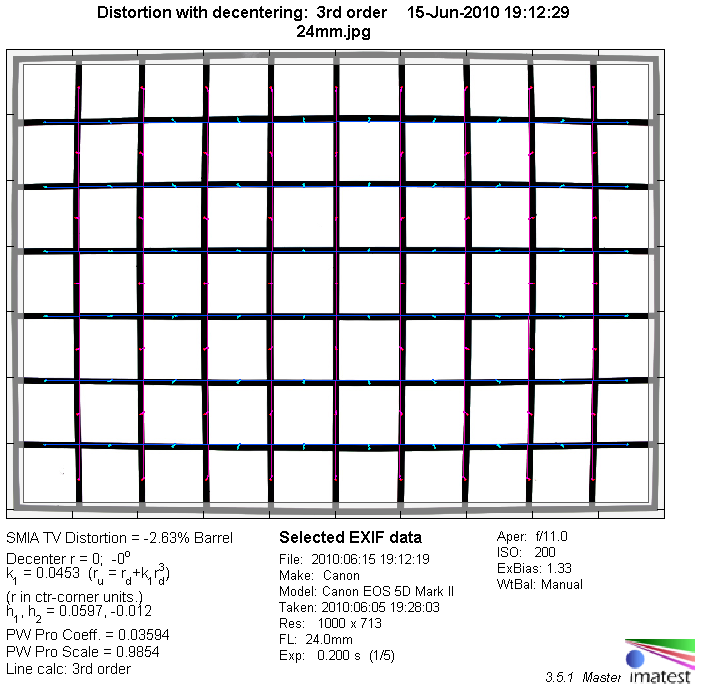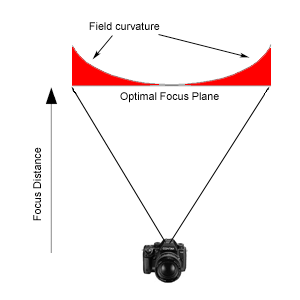|
Canon EF 24-70mm f/2.8 USM L - Full Format Review / Test Report - Analysis |
|
Lens Reviews -
Canon EOS (Full Format)
|
|
Page 2 of 3

Distortion
The distortion characteristic is above average for a lens in this class. Th lens produces pronounced barrel distortion at 24mm (~2.6%) which eases towards the middle of the zoom range. At 40mm there's only a slight hint of barrel distortion (0.7%) changing to a slight pincushion type at 70mm (1.1%).
|
Move the mouse cursor over the focal length text marks below to observe the respective distortion
|
| 24mm |
40mm |
70mm |
|

|
The chart above has a real-world size of about 120x80cm.
Vignetting
The vignetting characteristic is also slightly better compared to other standard lenses that we've tested so far.
That said there's still a heavy amount of light fall-off at 24mm @ f/2.8 (2EV) which will be easily visible in
field images. The issue is well controlled at 40mm and 70mm although it's still far from being insignificant at f/2.8.
Stopping down to f/4 resolves most of the issue at 40mm/70mm and at f/5.6 it's also no longer field relevant at 24mm anymore.

Field Curvature
Normally we'd present the resolution characteristic to you at this point but we'd like to show you an important
aspect of the Canon EF 24-70mm f/2.8 first - field curvature.
Let's assume a perfect lens - its focus field would be perfectly flat so the famous "brick wall" test scene would
be in focus from the very center all the way up to the extreme corners of the image field. Depending on the chosen
aperture you'd still have a sharp zone in front and beyond the focus plane - this zone is called the depth-of-field.
However, in the real life such perfect lenses do not exist. The focus "plane" is never really a plane but more or
less (radially) distorted. Normally the amount of focus distortions or "focus field curvature" isn't overly significant
but there're some lenses where the field curvature is much more pronounced and, unfortunately, the
Canon EF 24-70mm f/2.8 USM L is among them.
At the wide-end of the zoom range the outer focus field is distorted to the background resulting in the unfortunate
effect that the foreground corners are pushed out of focus compared to the center (or vice versa). The following
illustration may help to visualize this kind of field curvature:

/
We've experienced the problem in the lab but it's also very obvious in field conditions. The scene below has been
taken at 24mm f/10. Now at f/10 you'd normally just rely on the AF which suggests a near-infinity focus
distance here. You'd waste some depth-of-field by this but normally everything would still be sharp at this
setting (based on this kind of scene). The result can be seen BELOW the sample scene. The extreme corners are
blurry - despite f/10 - whereas the lower center is perfectly sharp.
Remember that we mentioned that the outer focus field is distorted towards background ? Well, the solution is to
"pull" the focus field towards you. The sample crops ABOVE the sample scenes show the effect of this action - the
corners are pulled into focus and the center remains sharp (within the depth-of-field). This "workaround" is
viable at small to medium aperture settings but it does naturally fail at large apertures where the depth-of-field
is not sufficient for such an approach anymore.

MTF (resolution)
Our MTF analysis is based on obtaining readings at the sharpest focus setting independent for the center as well
as the image borders/corners. It's field curvature invariant. Normally this is a preferable approach because the
field curvature isn't really relevant for most lenses and taking the field curvature not into account would
produce rather strange resolution curves. However, as mentioned field curvature is a very significant issue on
the Canon lens at the wide-end of the range so please keep this in mind here.
The Canon lens has a mixed but still decent resolution characteristic across the range. The center performance is very
good at 24mm f/2.8 and it reaches excellent levels from f/4 till f/11. The border quality is also very good at max.
aperture which is quite an achievement for a full format lens and it continuous to increase slightly towards medium
apertures. The extreme corners are relatively soft at f/2.8 but they improve gradually the more you stop down.
At f/8-11 they're also on a very good level (just).
The sweet spot of the lens is located in the middle part of the zoom range. The lens is already very sharp across
the image field at 40mm @ f/2.8 and the local peak performance is reached between f/5.6 and f/8 here.
There's a quite pronounced drop in performance at 70mm. The borders and corners are both quite soft here and the
center isn't all that stellar either at f/2.8. However, the results get pretty snappy at medium aperture settings.
It should be mentioned that the Canon EF 24-70mm f/2.8 USM L is a bit of a personal nemesis. A couple of years ago
I tested the lens on the old EOS 350D (APS-C) and it took me 4 (f-o-u-r) samples of the lens to get a good one
- please note: "good", not a "great" sample. The first three variants showed rather hefty centering defects
which spoiled the results quite a bit. Actually I didn't really want to test this lens anymore but we were able
to get our hands on the "good" sample again so ...
Please note that the MTF results are not directly comparable across the different systems!
Below is a simplified summary of the formal findings. The chart shows line widths per picture height (LW/PH) which can be taken as a measure for sharpness.
If you want to know more about the MTF50 figures you may check out the corresponding Imatest Explanations
Chromatic Aberrations (CAs)
Lateral chromatic aberrations (color shadows at hard contrast transitions) are well controlled.
They do not exceed 1px on the average at the image borders. This may be visible (just) but it's
hardly disturbing and superior to most competing products.

Bokeh
The EF 24-70mm is a comparatively "fast" lens thanks to its max. aperture of f/2.8. It's surely
not as capable as tele prime lenses but you can achieve a quite shallow depth-of-field specifically
at 70mm so let's have a look at the bokeh (out-of-focus) quality now.
The background blur is very smooth and buttery resulting in a very pleasing bokeh in many
"mainstream" scenes. However, the foreground blur isn't quite as harmonious. Out-of-focus highlights
show a near circular shape at large aperture settings but the inner zone of these "discs" is quite
busy/nervous (see also the "meadow" in the sample image section). All-in-all the bokeh
may not be flawless but it's still decent for a standard zoom lens (such lenses are rarely perfect
here).

Bokeh Fringing / Longitudinal Chromatic Aberrations (LoCA)
Bokeh fringing at large apertures is a problem which is often not well corrected. The Canon lens
has an average characteristic here - you should be able to spot some green and purple halos in out-of-focus
areas in the 70mm f/2.8 sample crop below. The issue eases at f/4 and it's not a really significant
anymore at f/5.6.
|
Move the mouse cursor over the f-stop marks below to observe the respective LoCAs
|
| f/2.8 |
f/4 |
f/5.6 |
|

|
These sample portions were taken at ~70mm.
|